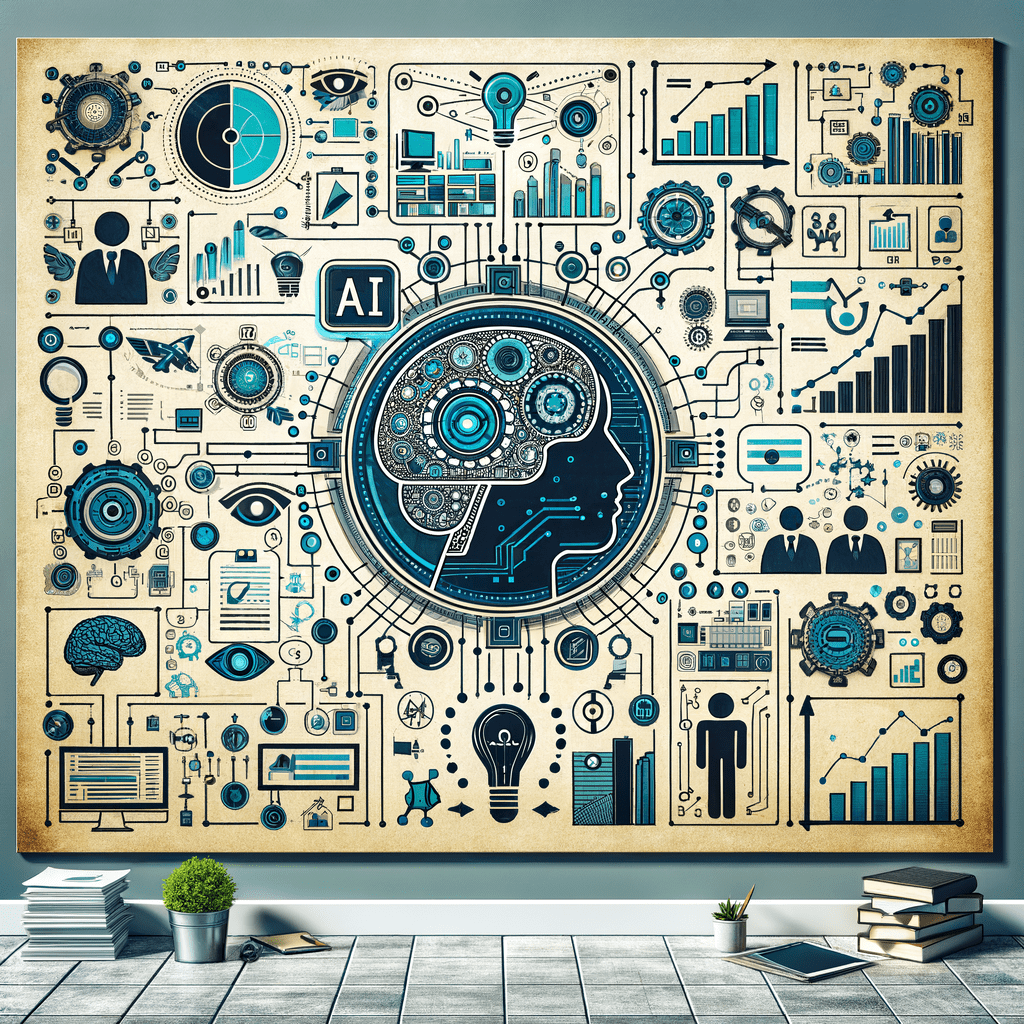Small business owners and team leaders, are you curious about how AI can help your business? Many business leaders are intrigued by the transformative technology of AI. But some hesitate due to common AI myths in business. This article addresses these common misconceptions head-on.
Common AI myths in business often prevent companies from fully embracing AI and leveraging its potential. Let’s clear the air and explore how AI can truly benefit your organization. This rapidly evolving global AI market is making itself available and known for its value added benefits to the workforce in countless industries.
Common AI Myths in Business Debunked
Myth 1: AI Will Replace Human Jobs
This is perhaps the most pervasive myth. While AI can automate specific tasks, it’s more about augmenting human capabilities than replacing them entirely. AI models help workers with specific tasks, improving their overall capabilities.
Gartner predicts that by 2028, 75% of enterprise software engineers will use AI-powered tools, not to replace them, but to boost productivity. AI takes on routine tasks, freeing up employees for strategic, creative work. Consider how generative AI and machine learning tools can empower your workforce, creating opportunities for growth.
Think of AI as a helpful assistant, not a job terminator. Human oversight and direction are critical for success.
Myth 2: AI is Too Expensive
The rise of cloud-based AI services and open-source tools has made AI more accessible than ever, even for small businesses. You can start small with focused pilot projects using affordable AI solutions. AI platforms and tools are widely available today to assist any business size. Many small and large platforms can automate specific tasks, enhancing efficiency for the modern workforce.
Scale up as needed, avoiding significant upfront investment. Platforms offer flexible, usage-based pricing, making AI much more attainable. Businesses implementing AI effectively will gain a competitive advantage.
Myth 3: AI Requires Perfect Data
While data quality matters, perfect data is a myth. AI systems learn and improve by processing new and more diverse inputs, not merely pristine datasets. This ongoing data stream helps the model to improve accuracy in all business use cases.
Start with the data you have and progressively refine it. Focus on consistent improvement in your data quality rather than perfection. Implementing AI requires understanding the data life cycle to ensure successful AI projects.
Myth 4: AI is Only For Tech Companies
AI applications extend across all industries. In customer service, AI chatbots give 24/7 support, enhancing customer satisfaction. AI-driven data analysis enhances business decisions and unlocks new business value. As more manufacturing companies and industries outside of technology implement these changes, this further fuels greater AI technology capabilities, features and potential value. Manufacturing AI today continues its global AI advancements. Common AI misconceptions about availability are no longer valid in this age of rapidly expanding tools.
Supply chain management gets a boost from AI-powered prediction, improving delivery and efficiency. AI can help you achieve a competitive advantage through greater productivity and enhanced accuracy for decision making and predictive analysis of common and infrequent trends or market shifts. AI capabilities in manufacturing include automated visual inspection, supply chain optimization, preventative maintenance and much more. As business leaders see this real value of integrating AI capabilities into their day to day work, AI accessibility makes integration that much more practical and viable.
Myth 5: AI is Too Complex to Use
Although the underlying tech might be complex, user-friendly AI platforms make implementation much simpler. Intuitive interfaces and available training let businesses leverage AI’s power, no matter their current tech expertise.
Many AI tools are being created today using low-code and no-code, so this business case continues to expand with this added simplicity for adoption. Tools designed to analyze data can be implemented effectively. AI tools are empowering non-data scientists to leverage the power of AI and data.
Myth 6: AI is Inherently Biased
AI systems themselves are not biased. Bias arises from the data they are trained on. Systems like GPT-4, which cost over $100 million to train, still depend greatly on data integrity, making data accuracy a primary focus moving forward. Ensuring unbiased, ethical AI solutions requires attention throughout the AI development lifecycle. Building an effective AI framework helps ensure proper outcomes.
If used carefully with continuous quality assurance, you can mitigate bias effectively. Consider partnering with experts in ethical AI development and bias detection tools.
Myth 7: AI is the Same as Machine Learning
While related, these concepts differ in computer science. Machine learning is a subset of AI, using algorithms to allow systems to learn autonomously from past datasets or behavior of a data source, but without explicit human instructions or programming. Models “learn” by processing data to make improvements. These improvements occur during model training, allowing models to further improve outputs and behavior during model tuning or refinement. Human supervision of the process remains critical.
AI is a much larger field encompassing various computer science techniques used in computer systems and tools including machine learning, deep learning, NLP, robotics and more. Tools designed for specific use cases or for greater versatility can help analyze data effectively. Leveraging ai services effectively, ensures your success in reaching your automation goals and overall project productivity needs.
Myth 8. Businesses Don’t Really Need AI
Companies already adopting AI report notable improvements. AI is transforming businesses and helping people work smarter, not harder.
| Company Type | Benefit |
|---|---|
| Consultants using GPT-4 | 40% performance improvement in creative product innovation (BCG Study) |
| Various Companies | Frees employees to focus on meaningful work (PWC) |
AI is transformative for efficiency and strategy. Businesses that don’t explore or test AI risk lagging behind their competition. While not necessarily critical, AI allows for far faster productivity at generally a cheaper cost, so adoption might still be worth it at some point.
FAQs about Common AI myths in business
How can AI negatively affect business?
While AI offers numerous benefits, there are potential downsides. If not implemented thoughtfully, AI can lead to job displacement. This necessitates retraining and workforce adaptation.
AI systems can also reflect biases present in training data, so careful data selection and ongoing monitoring are important. Cybersecurity risks tied to AI systems need proactive mitigation as well. Finally, relying heavily on AI could affect decision-making agility.
People involved should focus on AI augmentation rather than complete automation in most circumstances.
What businesses use AI the most?
Currently, tech companies lead in AI adoption. They use AI for everything from streamlining processes to providing improved customer experiences.
The healthcare, financial, and auto industries are fast adopters too. Even small businesses are finding ways to integrate AI tools for marketing, sales, and customer service. The applications and ease-of-use for small businesses mean wider adoption, leading towards greater competitive opportunities for more forward-thinking brands. Integrating AI effectively requires a tailored approach and careful consideration of AI capabilities.
What business problem is solved by AI?
AI excels at solving diverse business issues. It helps with complex analyses in finance. In healthcare, AI bots enhance responsiveness and satisfaction while keeping operational costs leaner.
It can further reduce manual or redundant labor needs so that operational costs are cut. AI assists in all phases of manufacturing from data analytics all the way up the line through automating factory or fulfillment centers. Data scientists work alongside business stakeholders in this rapidly evolving environment.
Why is AI a threat to business?
Viewing AI solely as a threat overlooks its potential to enhance operations. When implementing AI into a business, consider human oversight, bias detection, data integrity, and transparency. Start smaller first to mitigate unforeseen issues.
With adequate testing to refine outputs or system behavior and well-defined boundaries of application or authority within business environments or use cases can be used to eliminate issues entirely while still gaining all the productivity gains of faster, less expensive output creation. Remember that building an AI-ready culture is key for businesses seeking more than just cost savings.
Conclusion
The truth about common AI myths in business is much more optimistic than doomsday scenarios paint. They can inhibit the use and practical implementation of business growth opportunities through these automated processes and enhanced creativity. Embracing AI offers numerous benefits to enhance processes and drive innovation.
While powerful, AI today largely plays a supporting role, making both professional and everyday experiences smoother. Integrating AI doesn’t eliminate humans; it allows people to work smarter. Businesses require human creativity and insights for a fully functional environment. AI platforms can offer tremendous growth potential to your current business processes by helping streamline workflows, repetitive tasks and generating new revenue streams from unused content.






